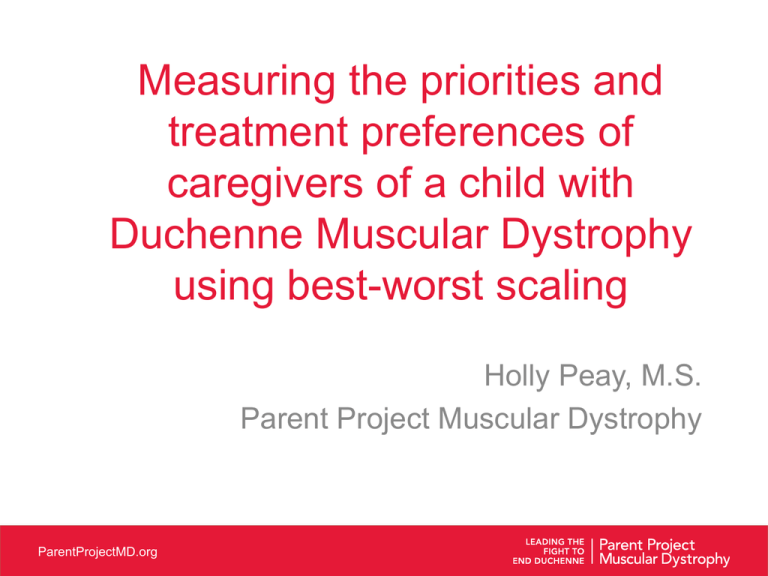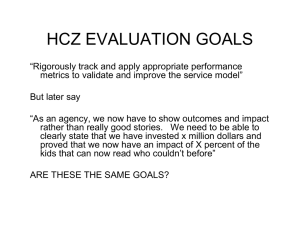Priorities and Preferences in Duchenne Muscular Dystrophy
advertisement

Measuring the priorities and treatment preferences of caregivers of a child with Duchenne Muscular Dystrophy using best-worst scaling Holly Peay, M.S. Parent Project Muscular Dystrophy ParentProjectMD.org “I understand the need for caution and care, but I also know that our children are dying. Parents should be able to decide the risk/benefit of a drug that has gone through and passed preliminary testing. I would rather my son die trying and fighting than waiting and wondering and wishing….I am one parent willing to take an educated risk!” PPMD “Share Your BRAVE Story” ParentProjectMD.org FDA FDASIA and PDUFA legislation (2012) • Committed the FDA to initiate the PatientFocused Drug Development Program • Aims to inform the FDA’s benefit/risk assessments and includes goals of systematically obtaining the patient’s perspective on disease impact and treatment benefits (http://www.fda.gov/forindustry/userfees/prescriptiondruguserfee /ucm326192.htm) ParentProjectMD.org A time of unique opportunity • How do we influence regulatory bodies? – Who represents patient/family preferences? • What do regulators want? – Less “emotion”? – More “patient stories”? – Quantifiable, generalized data? • What does the community want? – What is a “good enough” benefit? – Is any risk too high for approval? – What information needed for decision making? ParentProjectMD.org Engagement models • Direct engagement via representation, consultation and/or testimony • Formal study of the preferences and views of patients and the public • “When asking the public to assist in determining health priorities, we should use techniques that allow people to reveal their true preferences. If not, why bother asking them at all?” (Gafni,1995) ParentProjectMD.org PPMD’s benefit/risk study Advocacy-led, community-engaged study to: 1. Quantify treatment preferences of caregivers for benefits and risk of potential treatments (BWS case 2) 2. Prioritize Duchenne-related worries of caregivers to describe impact (BWS case 1) – Compare worry priorities of parents of ambulatory and non-ambulatory children ParentProjectMD.org A BWS benefit: • Offers alternative to complex algorithms: score a level given the times a level was rated as best or worst. – Level receives +1 if rated as best – Level received -1 if rated as worst – Level receives 0 otherwise • An approximation to the utility of the level is given by averaging the score, or as – Score = (B – W)/N – where N is the number of times a level appears across all choice sets. ParentProjectMD.org Treatment preferences • Hypothetical treatment features (attributes) identified and refined in consultation with parents, clinicians, researchers and industry • In-depth pilot testing with 7 parents • Parents/guardians identify what parts of each treatment were best and worst • Experimental design identified 18 potential treatments that systematically varied across the six chosen attributes ParentProjectMD.org Attributes and levels • • • • Effect on muscle function (none, slows, stops) Gain in expected lifespan (none, 2, 5 years) Post-approval information (none, 1, 2 years) Nausea (none, loss of appetite, loss of appetite and occasional vomiting) • Risk of bleeds (none, risk of bleeding gums and increased bruising, risk of hemorrhagic stroke) • Risk of heart arrhythmia (none, risk of harmless heart arrhythmia, risk of dangerous heart arrhythmia and sudden death) ParentProjectMD.org Example BWS choice task Best Treatment Worst ○ Slows the progression of weakness ○ ○ 2 year gain in expected lifespan ○ ○ 1 year of postapproval drug information available ○ ○ Causes loss of appetite ○ ○ Increased risk of bleeding gums and increased bruising ○ Increased risk of ○ harmless heart arrhythmia ParentProjectMD.org ○ Choose the best thing in this treatment by clicking the circle under “best” and choose the worst thing by clicking the circle under “worst”. You have to choose a best thing and worst thing to move on. Remember that a computer chose the combinations to make the experiment work, and some of them seem bad. Even so, please pick the best and worst thing. DMD worries: BWS case 1 • Responsive to the FDA’s request to understand disease impact • Aim: prioritize “qualitative” DMD-related worries using quantitative methods • 5 parents contributed worries, ultimately resulting in list of 16 DMD-related worry statements after stakeholder engagement, categorized under 4 domains • Pilot study conducted with 7 parents ParentProjectMD.org Worries and domains Domain Child affect Family and social Child medical concerns Parent well-being ParentProjectMD.org Attribute description My child feeling happy My child having good friends My child not being able to express deep worries My child feeling like a burden on the family The wellbeing of my other children Effect of Duchenne on my closest relationships My child becoming independent from me over time Feeling isolated from other families My child getting weaker Getting the right care for my child over time My child missing out on new treatments Affording care my child needs within the family budget Managing my uncertainty about my child's future Being a good enough parent for my child Me handling the emotional demands of Duchenne Having time for myself BWS worry choice task In the past 7 days, choose which of the following concerns you have been most worried about and which you have been least worried about. Most worried ○ ○ Concerns My child having good friends The wellbeing of my other children Least worried ○ ○ ○ My child not being able to express deep worries ○ ○ Being a good enough parent for my child ○ ○ My child feeling like a burden on the family ○ ○ ParentProjectMD.org My child feeling happy ○ Recruitment • Recruitment: – Using PPMD, DuchenneConnect Registry, and snowball recruiting • Inclusion/exclusion: – At least one living child with DMD, living in the US, over 18 years of age, and able to complete an online survey in English • Ethics: – Study determined to be exempt by the Western Institutional Review Board ParentProjectMD.org Participant characteristics Caregiver age in years Relationship to child(ren) Biological mother Biological father Adoptive mother Adoptive father Marital status Married/long-term relationship Divorced/Separated Widowed Race Caucasian Education High school/GED Some college Technical school Associated degree Four-year college degree Graduate/professional degree Income <$25,000 $25,000-$50,000 $50,000-$75,000 $75,000-$100,000 >$100,000 ParentProjectMD.org Mean (SD) 43.7 (SD=7.7) 67.2% 28.6% 3.4% 0.8% 89.9% 9.2% 0.8% 91.6% 4.2% 14.3% 5.0% 7.6% 42.9% 25.2% 5.9% 8.4% 18.5% 18.5% 47.1% Sample (119) Child characteristics Child age in years Number of affected children One child Two or more children Living arrangements In caregiver's home Independent Other Ambulation status Ambulatory Non-ambulatory Research participation Clinical research Clinical trial Had life-threatening emergency Yes No Percent 21.1 (SD=6.4) 92.4% 7.6% 98.3% 0.8% 0.8% 63.9% 36.0% 58.0% 34.0% 18.5% 81.5% Figure 2. Relative best-worst scores for attribute levels and relative attribute importance 1.0 Effect on muscle function Lifespan Knowledge about drug Nausea Risk of bleeds Risk of heart arrhythmia Relative best-worst score 0.8 0.6 0.4 0.2 0.0 -0.2 -0.4 -0.6 -0.8 -1.0 Stops Slows None Levels 0.877 0.800 -0.08 Relative attribute importance 28.66% ParentProjectMD.org 5 yr 2 yr None 2 yr 1 yr None None Mild Mod None Mild Sev None Mild Sev 0.464 0.408 -0.11 0.056 0.022 -0.02 -0.01 -0.13 -0.28 -0.01 -0.26 -0.72 -0.03 -0.16 -0.78 17.29% 2.31% 8.10% 21.23% 22.41% Worry Prioritization by Ambulation Status -2.500 -2.000 -1.500 -1.000 -0.500 0.000 0.500 1.000 1.500 2.000 2.500 B. Child getting weaker C. Getting the right care A. Miss out new treatments D. Child feeling happy L. Managing my uncertainty P. Affording care E. Child having friends H. Not able to express worries Ambulatory Non-ambulatory J. Good enough parent R. Wellbeing other children K. Handling emotional demands F. Child feeling like burden Q. Effect on closest relationships G. Child becoming independent N. Isolated from other families M. Time for myself ParentProjectMD.org 3.000 Conclusions Preference experiment: – Stopping/slowing the progression of muscle weakness accounted for the largest proportion of the variation. – The presence of side effects/risks could be compensated for by a treatment that stops/slows progression to muscle function. Worries experiment: – Child’s disease management was ranked as of greatest concern, followed by child’s affect. – Impacts of DMD on the family and parents’ wellbeing were less prioritized. ParentProjectMD.org Some benefits of communityengaged approach • Identify the “right” attributes and levels – Meaningful to patients/families – Acceptable to other stakeholders • Set up the experiment “properly” for the community • Bring together stakeholders in a mutuallybeneficial process • Give the community a productive action ParentProjectMD.org Engaging the FDA • On July 9, 2013, PPMD met with Dr. Janet Woodcock and senior staff from FDA; one objective: review BR results • On December 12, 2013 PPMD held an FDA/community engagement meeting that also covered the BR study • Anecdotally, FDA senior staff have encouraged other advocacy organizations to use it as a model ParentProjectMD.org Acknowledgements • Co-authors: – John Bridges, JHSPH – Ilene Hollin, JHSPH – Hadar Sheffer, PPMD – Ryan Fischer, PPMD This research was supported through funding from Parent Project Muscular Dystrophy (PPMD). ParentProjectMD.org Results: Treatment preferences Best Worst Utility SE Treatment benefits and risks Stops progression of weakness Slows progression of weakness Does not change progression of weakness 5 year gain in expected lifespan 2 year gain in expected lifespan No extra gain in expected lifespan 2 years of post-approval drug info available 1 years of post-approval drug info available No post-approval drug info available No increased chance of nausea Causes loss of appetite Causes loss of appetite with occasional vomiting No increased risk of bleeds Increased risk of bleeding gums and increased bruising Increased risk of hemorrhagic stroke and lifelong disability No increased risk of heart arrhythmia Increased risk of harmless heart arrhythmia Increased risk of dangerous heart arrhythmia and sudden death ParentProjectMD.org 628 571 68 348 299 12 109 20 41 19 1 17 3 0 0 5 1 0 2 0 125 17 8 93 69 4 56 26 95 217 11 190 514 32 122 0.877 0.800 -0.080 0.464 0.408 -0.113 0.056 0.022 -0.021 -0.010 -0.132 -0.280 -0.011 -0.266 -0.720 -0.038 -0.169 0.01 0.02 0.02 0.02 0.02 0.01 0.02 0.01 0.01 0.01 0.01 0.02 0.01 0.02 0.02 0.01 0.01 PT-test Value 69.4 <0.001 53.4 <0.001 -4.1 <0.001 22.7 <0.001 21.2 <0.001 -8.3 <0.001 3.0 0.001 3.3 0.001 -1.5 0.064 -1.0 0.148 -10.3 <0.001 -15.0 <0.001 -2.1 0.016 -16.1 <0.001 -42.8 <0.001 -4.5 <0.001 -11.9 <0.001 561 -0.786 0.02 -51.1 <0.001 Results: Worry prioritization Worry Domain MC MC MC CA Estimate 0.93 2.30 1.00 0.67 Std Error 0.073 0.074 0.073 0.076 Z score 12.73 31.09 13.64 8.84 P-value p<0.001 p<0.001 p<0.001 p<0.001 Child missing new treatments Child getting weaker Getting the right care over time Child feeling happy Child having good friends Child feeling like burden Child becoming independent Child unable to express worries Good enough parent Handling emotional demands Managing my uncertainty Having time for myself Isolated from other families Affording care my child Effect on closest relationships ParentProjectMD.org Wellbeing of other children CA CA FS CA PWB PWB PWB PWB FS MC FS FS 0.10 -0.67 -0.85 0.09 -0.05 -0.20 0.49 -1.97 -1.10 0.27 -0.85 -0.16 0.076 0.073 0.071 0.075 0.083 0.076 0.076 0.071 0.071 0.074 0.072 0.078 1.34 -9.22 -11.92 1.27 -0.61 -2.65 6.43 -27.59 -15.5 3.67 -11.77 -2.12 0.18 p<0.001 p<0.001 0.21 0.54 0.01 p<0.001 p<0.001 p<0.001 p<0.001 p<0.001 0.03


